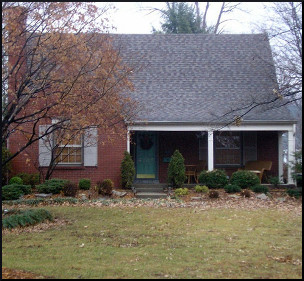
America is full of empty houses, a circumstance that House the Homeless
has been exploring to figure out why people can’t live in them. A Cleveland, Ohio, man took that question from theory to reality when he began to practice urban homesteading six years ago. Mr. Hayes is, by all reports, a model neighbor who maintains the small abandoned house in which he lives as well as possible, considering that he is not allowed either water or power.
He gets around these strictures by paying a neighbor to use some electricity via an extension cord, and collects rainwater to filter for drinking and to fill the toilet tank. A disability check covers his modest living expenses and those of his two dogs. The building’s owner is not even a real person, but a corporate entity of whom reporter Mark Naymik says:
The company, whose leaders are nearly impossible to track down, owes tens of thousands in back taxes and penalties on its properties. The company owes $27,000 alone on the house Mr. Hayes is living in.
But Mr. Hayes pays property taxes, and keeps the place neat, and helps an elderly neighbor. He asked a city council member:
Would you, please, introduce an amendment to the ordinance so that qualified people may put to good use properties that are verifiably abandoned?
Why is there not such a law in every city across the country? Curious journalist Matt Lemas took the question a step farther and explored the notion of letting people live in the 77,000 empty buildings owned by the U.S. Government. In contrast to Mr. Hayes’s minimalist dwelling, many of these places even have electrical service. That’s right—regulations keep the power on to satisfy “safety requirements” for the structures, while actual humans live unsafely outside in the dark and cold. In fact, the upkeep for empty government-owned buildings costs taxpayers $1.7 billion per year.
The Philadelphia Stabilization Program
House the Homeless is not Richard R. Troxell’s first project. He has been involved in many other programs and initiatives to improve the lives of people experiencing homelessness. In the 1980s he lived in a Philadelphia neighborhood where a 55-block area held 110 abandoned houses, the overwhelming majority of which were built from stone or brick.
The first step of his group’s master plan was to prevent further deterioration by securing doors and windows with plywood to keep the weather out. They negotiated a deal with the union to have the roofs repaired, and put sturdy Lexan in the windows. Crews gutted the interiors, businesses donated paint, and kids recruited from the anti-graffiti program painted the exterior trim. The result would be a sturdy structure with the soft parts stripped down and prepped. Richard recalls:
A local bank agreed to offer a mortgage with rehab and wrap-around loans so the buyers could purchase the shells and have money to rehabilitate them.
His group kept the lawns mowed and transformed vacant lots into community gardens. They opened talks with city authorities and HUD, looking for support from the Community Development Block Grant program so potential homeowners with the fixer-upper mindset could afford mortgages and rehabilitation loans.
Progress was moving along nicely when the drug epidemic hit. The Philadelphia neighborhood, like many others all across the country, became a war zone, and the group realized that it had to move quickly to stabilize the neighborhood as it was rapidly being turned into fortified crack houses. Charged with the impossible responsibility to fully, completely, and permanently pacify the neighborhood, the rehabilitation group found that financial government support was about to be pulled. A further response by the fast-thinking neighbors enabled them to go forward with their stabilization plan.
Absent the crack epidemic, the basic plan was solid. At the time, the United Nations was researching best practices as part of the International Year of Shelter for the Homeless. Richard was urged to submit the plan, under the name of “Permanent Housing of Homeless People in Philadelphia,” and received special recognition for it.
The whole story is in his book, Looking Up at the Bottom Line, along with many other fascinating and instructive episodes.
Source: “Homeless man pays property taxes after moving into abandoned Cleveland home to fulfill homesteading dream,” Cleveland.com, 02/20/14
Source: “Could We House the Homeless in America’s 77000 Empty Government Buildings?,” RYOT.org, 2014
Image by w.marsh


